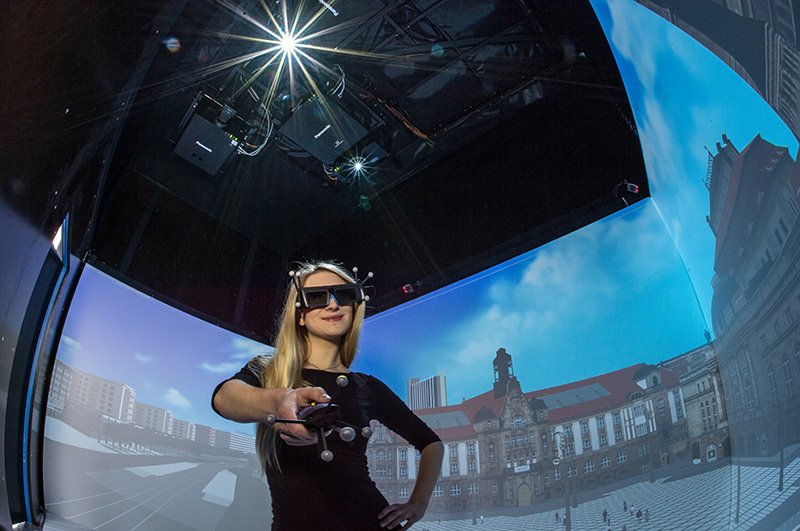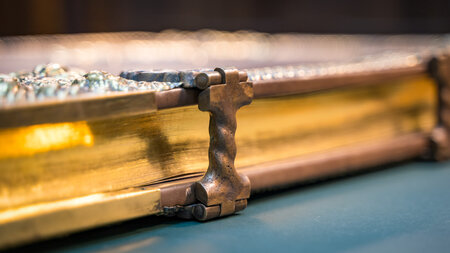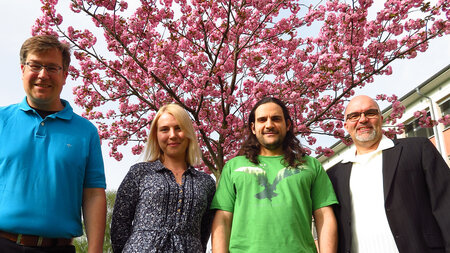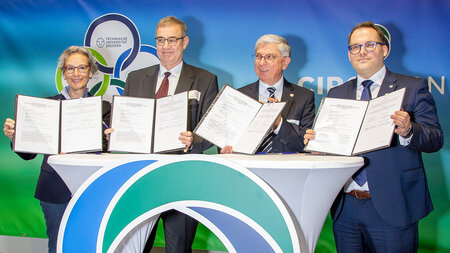For the WOW-Effect on Wheels
Computer scientists of the Professorship of Computer Graphics and Visualization developed a mobile 3D-projection container in cooperation with industry partners, which is not just for showcase
Virtual reality (VR) still acts magically on novice users, though the technology became an important tool for companies to reach potential customers. Designs of new cars, devices, or ready-made products are demonstrated on fairs using sophisticated technical installations. The most impressive presentations utilize a CAVE (Cave Automatic Virtual Environment)with high-quality multi-projector installations. A considerable challenge in developing such systems is the shadow- and blending-free visualization on the ashlar-formed or cubically aligned projection planes. The images also have to be seamlessly aligned at the edges and accurate in terms of perspective. “The technical construction and the necessary deskew on pixel-level as well as aligning the images is very difficult and in turn costly in terms of processing time and expense”, reports holder of the Professorship of Computer Graphics and Visualization Prof. Dr. Guido Brunnett.
Computer scientists of the TU Chemnitz developed a mobile 3D-projection system based on this problem statement. The development process took two and a half years and involved numerous industry partners from Saxony. The system has been realized within a robust container to feature a unique mobility. Brunnett: “The whole CAVE merely requires the space available inside a standardized container used by industry and can therefore be realized in a special transportable sized container. The whole system can be carried by a regular truck without the necessity of a special permission. The device unfolds itself on location and exposes the entrance. Bringing the device into service at a fair or any other venue takes only three to four hours.”
The heart of the “3D-Cube” from Saxony is the 4-sided CAVE. Front-side and floor measure 3.7 times 2.25 meters. Both lateral faces have an extend of 2.25 times 2.25 meters. The displayed images are are up to FullHD in resolution for each side and very bright. The 3D-impression is realized by special shutter-glasses, which are required to view 3Dimages. The main glasses are equipped with head-tracking to supply position, situation and movement of the user’s head to the system. The valid presentation depends on the current viewing angle and is achieved by taking the data from the glasses into account during the rendering of the virtual scene. The main task for the Professorship of Computer Graphics and Visualization was the planning and development of the container’s whole projection and VR-IT-technology. “The hard- and software is responsible for the image creation as well as the management of the projection system. At the same time, it is also the interface between the CAVE and the application.”, reports project associate Mario Lorenz. The architecture of the interface guarantees that virtually any VR-application can be used by the system. Essential, according to Lorenz, is the utomated calibration system, which configures the four projectors’ default values. This system makes the laborious fitting of the optical and fine mechanical projector components after a transport obsolete. “A special software, which calculates the necessary image correction from photographs of the current state, was developed for this purpose at the Technische Universität Chemnitz. The calibration system applies the corrections in real-time to the images and guarantees an accurate and valid presentation of the VR-scene”, explains Lorenz.
The new CAVE allows for a high dimension of liveliness and interactivity and creates a highly immerse experience for the user. A significant role to create this effect plays the large image space, which surrounds the user almost completely. “The desired WOW-effect is especially intense on novice VR-users, since the 3D image creation is always tailored to their current position and viewing angle“, states Lorenz. Body and head movements result in a changed perspective, so that the user can look around and compass objects in front of him in a natural way.
The research project was partially funded by the government through the funding program “Zentrales Innovationsprogramm Mittelstand (ZIM)” (central innovation program for small and medium-sized businesses). Involved companies have been, upon others, Menzel Container Vermietung und Verkauf GmbH from Lichtenau, EPM Schaltanalgen GmbH from Frankenberg, Golle Zelte & Planen GmbH from Plauen, WIKOMEDA located in Radebeul, as well as WOLFRAM DESGIGN from Dresden. “The successful collaboration of the involved companies and research institutes resulted in a bundled expertise, which rendered the simple and cost effective transportation, the easy and fast buildup, the high reliability of operation, the equipment’s protection from exterior influences, and the full-fledged compatibility with VR-software possible”, states Brunnett proudly.
The prototype of the “3D-Cube” was located at the inner courtyard of the Bötcher building at the TU Chemnitz for the last few months to assemble all the developed parts of the partners into one system. Students of the faculty for computer science already had the opportunity to explore the new system and dive into the virtual world. The container will be merchandised through the project’s consortium - leading by the Menzl Container Vermietung und Verkauf GmbH - in the near future. “The main objective is to make our mobile facility and the realized VR-presentation system accessible to a larger group of people. For example, companies should be able to present their prototypes, which exist as computer models only, at fairs in a lifelike fashion to potential customers”, previews Brunnett.
Further information are supplied by Prof. Dr. Guido Brunnett and Mario Lorenz through phone at ++49 371 531-31533 or -31441 as well as via eMail at mario.lorenz@tu-chemnitz.de.
(Author: Mario Steinebach, Translation: Tom Uhlmann)
Mario Steinebach
25.04.2016






